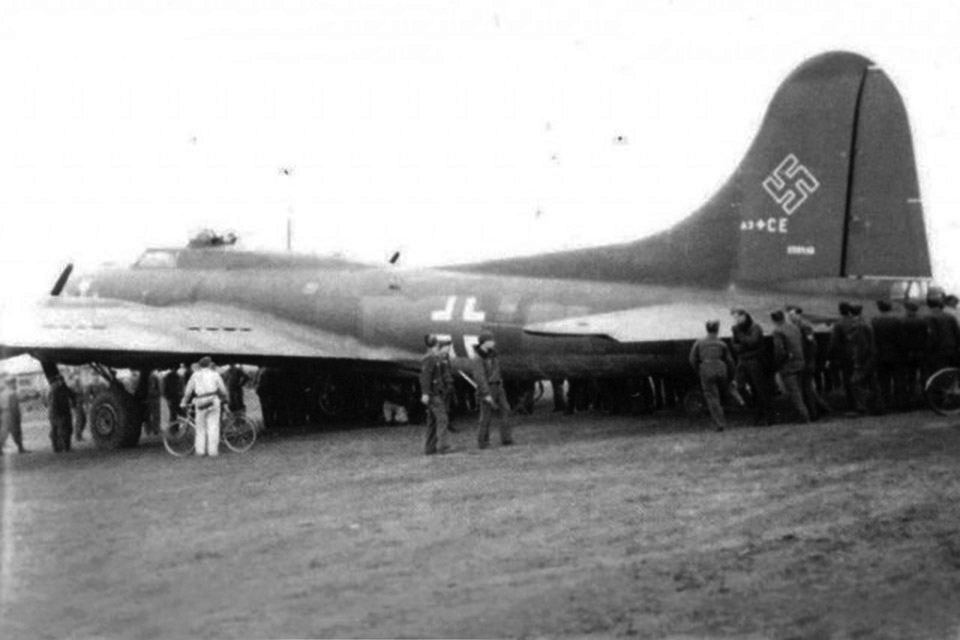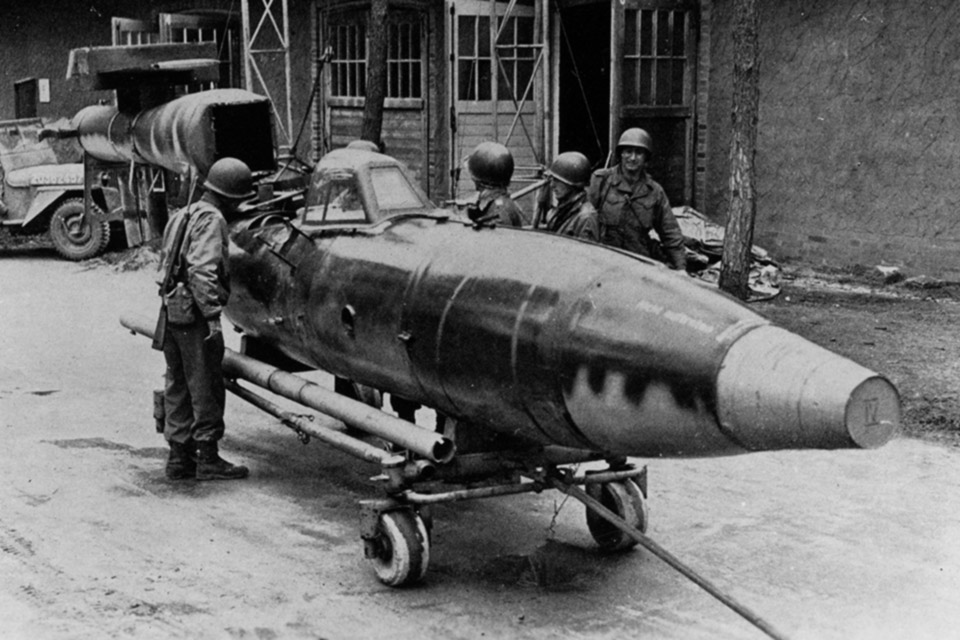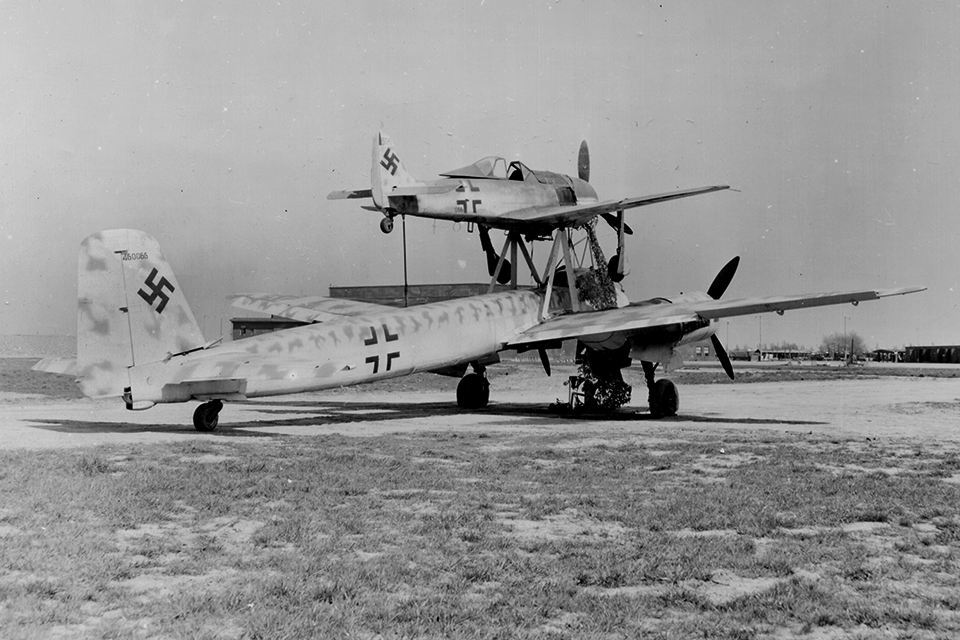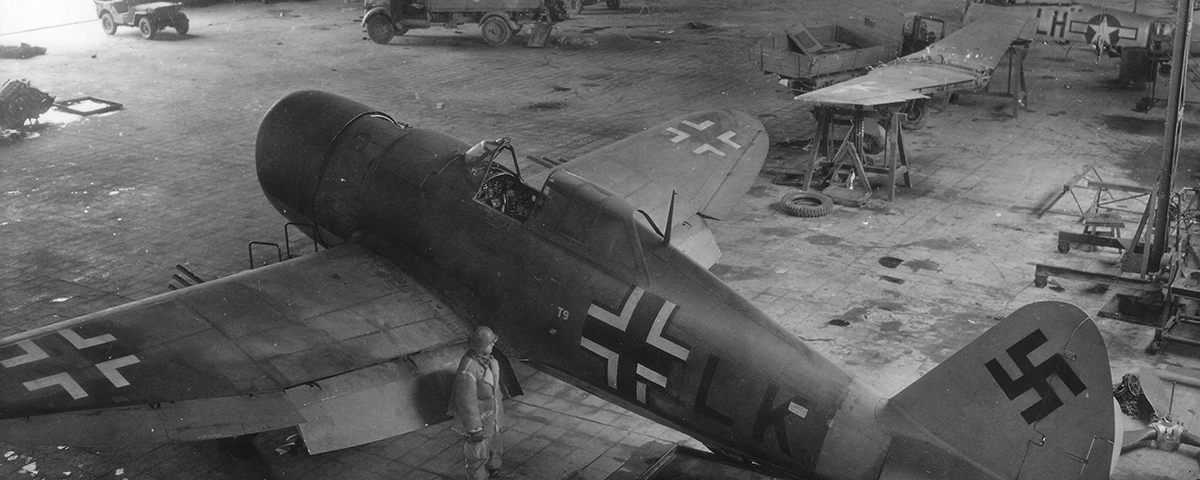The history of the German Luftwaffe in World War II has been examined by scores of authors and eyewitnesses. The case of Kampfgeschwader (Battle Wing) 200, or KG 200, is a different story, however. The real story of this special Luftwaffe unit has remained shrouded in mystery, and most members maintained their silence after the war. The commander of the unit, Colonel Werner Baumbach, a winner of the Knight’s Cross and a celebrated Junkers Ju-88 bomber pilot, did not even mention KG 200 in his memoirs, Broken Swastika.
KG 200 was a unique unit, which operated a wide variety of aircraft—from the Blohm und Voss Bv-222 Wiking (one of the the largest flying boats of the era) to the Junkers Ju-52, Ju-90, Ju-290 and Ju-188, the Heinkel He-111, and even captured British and American aircraft such as the Consolidated B-24 Liberator and the Boeing B-17 Flying Fortress.
The earliest incarnation of KG 200 was Special Squadron Rowehl, a unit subordinate to the Abwehr, the German military intelligence organization. Colonel Theodor Rowehl, who had been a reconnaissance pilot in World War I, heard rumors that Poland was building new forts along its border with Germany. Now a civilian, Rowehl began flying photoreconnaissance missions over Poland in civilian aircraft. (Military planes were not allowed to fly in that area.) The Abwehr was impressed with Rowehl’s photographs and paid him to continue his flights. From 1930 to 1934, Rowehl flew solo reconnaissance flights as a civilian. A short time later, he put together a squadron of airmen that was given an official military designation. His efforts led to the creation of a unit operating for the Luftwaffe’s 5th Branch (air intelligence). The new unit flew high-altitude photoreconnaissance missions over all of Europe, Africa and the Soviet Union in a wide variety of military and civilian aircraft.

During the late war period, when the Abwehr fell under a cloud of mistrust due to anti-Hitler activities, the prestige of the squadron suffered through its association with the intelligence arm. Captain Karl Edmund Gartenfeld, a specialist in long-range reconnaissance and navigation and in inserting agents behind enemy lines, formed his own new unit in the summer of 1942. By 1944 his squadron, the 2nd Test Formation, had grown to a group of four squadrons.
KG 200 was officially formed by order of the German air force high command on February 20, 1944. In March 1944, the 2nd Test Formation was united with the 1st Test Formation, a research squadron. This combined unit came under the command of then Lieutenant Colonel Werner Baumbach and was renamed KG 200. The 2nd Test Formation became the first group of the new KG 200, and Gartenfeld was replaced by Major Adolf Koch. Within days, 32 types of aircraft were ready for use, complete with 17 fully trained crews. Heavy training began at once, and by the end of July 1944, five new crews were ready, and refresher classes had been provided for 75 additional crews. Even at this early stage special missions were already being flown.
KG 200 was divided into several sections, each of which had subsidiaries across the German empire. The first group (I/KG 200) handled agent work; the first squadron (1/KG 200) handled long-distance operations; 2/KG 200 covered short-range operations from various “outstations”; 3/KG 200 was concerned with transport and training duties and was based at the Baltic island of Ruegen, later Flensburg; 4/KG 200 handled technical matters. The second group (II/KG 200) provided pathfinders, radar-jamming aircraft, bombers and Mistel composite aircraft; 7/KG 200 handled replacement and training for II/KG 200.
The first two groups of KG 200 were the only ones ever fully developed, although several other projects were planned. III/KG 200 was to have fitted Focke-Wulf Fw-190 fighters with torpedoes but never did. IV/KG 200 was the training and replacement group for KG 200 and trained the nearly 100 “self-sacrifice” pilots who flew the Reichenberg modified V-1 suicide weapons. KG 100, which handled Fritz X and Hs 293 guided missiles, was also associated with KG 200. The fifth long-range reconnaissance group flew Ju-90s and Ju-290s on their missions. The test unit of the Luftwaffe commander flew high-altitude reconnaissance and testing aircraft and also conducted evaluation flights of captured Allied aircraft.
2/KG 200 covered different combat fronts from various outstations. The headquarters of each outstation was located in a wooded area, and the airfield had to appear abandoned during the day in order to avoid unwanted Allied scrutiny. Outstation Carmen, in northern Italy, covered the western Mediterranean, the southern Mediterranean, and North and West Africa. Outstations Klara and Toska handled the Eastern Front, and Detachment Olga covered Western Europe, England, Ireland and Iceland (and later took over Carmen’s areas as well).
By 1944, because of the increasing action on the Western Front, Detachment Olga at Frankfurt am Main was very busy. Olga was commanded by P. W. Stahl, an experienced pilot who had flown supply missions in the fall of 1942 to Finnish long-range reconnaissance units operating deep in Soviet territory. His book, KG 200: The True Story, is one of the few accurate accounts of the unit.
Despite its importance, Outstation Olga was little more than a rough runway beside a forest. The command post consisted of two huts hidden in the woods. The operational aircraft included six Junkers Ju-188s and a pair of captured and renovated Boeing B-17s, redesignated Dornier Do-288s. Enemy “Jabos,” as the Germans called Allied ground-attack aircraft, were overhead so often that personnel took the precaution of dodging from tree to tree, never appearing in the open during daylight.
Detachment Olga was responsible for landing agents in France, which was under Allied control. The KG 200 pilots usually dropped agents by parachute, but on some flights they would drop a personnel drop device—a metal and plywood container holding three agents and their equipment that would parachute to earth. The KG 200 pilots made supply runs to keep their covert activities in operation.
Agents were trained at the Reich Main Security Office’s well-fortified luxury hotel, on a mountain in southwestern Poland. The hotel was ringed by guards and could be reached only by cable-car. Upon graduation, the new agents were sent to KG 200 for transport to their areas of operation.
These secret missions were only flown at night, and the runway lights were turned off as soon as the aircraft had taken off or landed. Under cover of darkness, as they dropped their passengers or acted as airborne listening posts, the KG 200 pilots and planes were relatively safe from attack. Landing was another matter; the airfields often came under attack and were extensively damaged while the KG 200 pilots were in the air, making landing impossible and leading to the loss of airplanes and crews.
Pressed by a shortage of long-range aircraft, KG 200 used captured Allied aircraft—given German markings—to fly their missions. Phyllis Marie, a Boeing B-17F, was one example. Phyllis Marie went down with battle damage on March 8, 1944, at Werben, Germany. The plane was captured and repaired from the large stock of B-17 spare parts that the Germans had amassed during the years of heavy daylight bombing attacks by U.S. planes. Phyllis Marie was painted with German markings, but otherwise it remained unchanged. U.S. forces recaptured the plane on a runway at Altenburg on May 4, 1945.
By July 1944, the war was turning against the German Reich on all fronts. Ernst Kaltenbrunner, commander (under commander in chief of the SS, Heinrich Himmler) of all SS intelligence operations and head of the Reich Main Security Office, informed the KG 200 operations officer that he needed to provide a plane that could fly almost to Moscow, land and unload cargo and people, all unnoticed. The purpose of that mission, code-named “Operation Zeppelin,” was to kill Josef Stalin. The aircraft chosen for the job was the Arado Ar-232B—a four-engine version of the Ar-232A Tatzelwurm (Winged Dragon)—known as the Tausendfüssler (Millipede) because of the 11 pairs of small idler wheels under the fuselage that were used to land on unprepared fields.
On the night of September 5, two agents, their baggage and their transport were loaded aboard, and the Ar-232B took off. The agents intended to reach Moscow, where they had a place to stay. They carried 428,000 rubles, 116 real and forged rubber stamps and a number of blank documents that were meant to gain them entry to the Kremlin so that they could get close to Stalin.
There was no word from the plane until long past its maximum projected flying time, and it was assumed lost. Then a radio message came from one of the agents: “Aircraft crashed upon landing, but all crew members uninjured. Crew has split up into two groups and will attempt to break through to the west. We are on the way to Moscow with our motorcycle, so far without hindrances.” The two would-be assassins were later captured at a checkpoint when a guard became suspicious of their dry uniforms on a rainy day. Some of the German crew did manage to make it back to friendly lines, but others had to wait until the end of the war to return.
Bizarre schemes and deceptions such as the Stalin assassination plot came from both sides. In October 1944, an agent who had been dropped behind Russian lines suddenly resumed contact with his controller in Germany with an astonishing story to tell. He was in contact with a large German combat group–2,000 men strong–that was hiding in the forested and swampy region of Berezino, roughly 60 kilometers east of Minsk. The Germans, under the command of a Colonel Scherhorn, had been caught behind Russian lines during the Wehrmacht retreat that summer. German intelligence accepted the report as true. KG 200 was dispatched to provide the German troops with supplies that the German high command hoped would allow Kampfgruppe (Battle Group), and for Scherhorn to break out and return to German lines. Not until April 1945 did the Germans learn that “Colonel Scherhorn” was in fact a Soviet operative using the name in an elaborate ruse.
KG 200 was also in charge of the German suicide pilots. The Germans mirrored the Japanese kamikaze efforts with the Reichenberg IV suicide bomb. The concept was developed by a glider pilot who was a veteran of the famous 1940 assault on the Belgian fortress of Eben Emael. As the war turned against Germany and his fellow pilots were slaughtered, he thought that if glider pilots were to be sent to perish, they should be armed with a suitable weapon to bloody the enemy. The Reichenbergs were to be piloted by “self-sacrifice men.” Thousands of men volunteered for vaguely defined “special operations,” and 70 of them were sent to KG 200.

Although these men were trained on gliders, they were to fly a manned variant of the V-1 buzz bomb. The V-1, also known as the Fiesler Fi-103, was already in mass-production for its primary purpose as a flying bomb. The German Research Institute for Gliding Flight at Ainring modified the V-1 to carry a pilot. By 1945, however, the attitude toward using the flying bomb had changed so much that only criminals or pilots who were in a depressed state or were ill would be allowed to fly Reichenbergs.
As early as 1942, researchers also began to develop Mistel (mistletoe), a piggyback aircraft—a smaller aircraft mounted above a larger, unmanned aircraft such as a medium-sized bomber. After a series of false starts, the combination settled upon was a Messerschmitt Me-109 or Focke-Wulf Fw-190 fighter atop a Junkers Ju-88 bomber. The machines were joined by a three-point strut apparatus, which was fitted with explosive bolts that would sever the connection when the carrier aircraft—armed with an 8,377-pound hollow-charge warhead in the nose—had been aimed at its target. The warhead would detonate on impact in an explosion that could penetrate 8 meters of steel or 20 meters of ferroconcrete.
By May 1944, the first operational Mistels were delivered to 2/KG 101, a unit closely affiliated with KG 200. The unit was originally slated to attack Scapa Flow in northern Scotland, but the Allied invasion of Normandy changed that plan. On the night of June 24, 1944, Mistels were dispatched against targets in the Bay of the Seine, in the English Channel. Although one of the Ju-88s had to be jettisoned prematurely, the remaining four pilots had successful launches and sank several block ships.
Luftwaffe planners placed all Mistels under the aegis of KG 200 and Colonel Joachim Helbig, an expert Ju-88 pilot. Task Force Helbig was handed a daunting and audacious plan—it had been decided that the Mistels would be used to single-handedly cripple the Soviet war industry. The operation, known as Plan Iron Hammer, was the 1943 brainchild of Professor Steinmann of the German Aviation Ministry, who had pointed out the benefit of raiding selected points in the Soviet infrastructure in order to damage the whole. Iron Hammer was meant to attack the Soviets’ Achilles’ heel—their electrical generation turbines. The Soviets relied on a haphazard system of electrical supply with no integrated grid, which revolved around a center near Moscow that supplied 75 percent of the power to the armament industry. The Germans sought to destroy an entire factory system in one quick blow.

The mission called for KG 200 to launch strikes against power plants at Rybinsk and Uglich and the Volkhovstroi plant on Lake Ladoga. The planes were to drop Sommerballon (summer balloon) floating mines. In theory, a Sommerballon would ride the water currents until it was pulled straight into the hydroelectric turbines of a dam, but the weapon never performed as designed. In addition, the unit soon became short on fuel, and the operation was halted.
Iron Hammer was resurrected in February 1945, with several new twists. The Soviets had overrun all the advance bases included in earlier planning, so the attack would have to be launched from bases near Berlin and on the Baltic. Mistels would now be the primary weapon. Furthermore, Iron Hammer had become a part of a master strategy to regain the initiative in the East. After the strike rendered the Soviet production centers impotent, the Wehrmacht would wait until the Soviets had exhausted their front-line materiel. Freshly rearmed Waffen SS divisions would swarm northward from western Hungary, attempting to drive straight to the Baltic Sea and catch the advance elements of the Red Army in a huge pincer movement. After the Soviets had been eliminated and Central Europe was safe, the Germans would negotiate a separate peace with the Western Allies, and the struggle against Bolshevism could be continued. Iron Hammer was never launched, however. American daylight raiders destroyed 18 Mistels at the Rechlin-Laerz air base. With this main strike force gone, the entire mission was rendered moot even before Iron Hammer was officially canceled.
On March 1, 1945, Hitler appointed Colonel Baumbach to the post of plenipotentiary for preventing Allied crossings of the Oder and Neisse rivers. At his disposal were Mistels and Hs-293 guided bombs. On March 6, an Hs-293 hit the Oder bridge at Goeritz. The same bridge was attacked two days later by five Mistels escorted by Ju-188 bombers. The Ju-188s scattered air defenses, and the Mistels destroyed two bridges.
These victories and those in following days did little to change the inevitable outcome of the war. KG 200’s remaining pilots and machines were shuffled to various air bases in futile attempts to destroy the Oder bridges. In Berlin, Baumbach was replaced by another officer, who released the KG 200 headquarters group on April 25, 1945. Some men changed into civilian clothes and attempted to reach the Western Allies, while others proceeded to Outstation Olga to continue the fight.
The American advance into Germany forced the relocation of Outstation Olga from Frankfurt am Main to Stuttgart, and then again to the Munich area, where the unit settled inside a Dornier aircraft factory. Stahl and company continued their duty until the situation became untenable. He issued discharge papers and a final service pay and said goodbye to his men.
After the war, the Allies sought out members of the ‘ominous secret group,”sure that they had been involved in spiriting Nazi officials out of Europe. The continuing mysteries and half-truths about KG 200 prompted Stahl to write KG 200: The True Story, “to clear up this business of ‘Hitler’s spy Geschwader.”’ He also attempts to justify his unit’s record: “The fact that not a single former member of KG 200 has ever been accused of any specific misdeed, nevermind prosecuted, speaks for itself.”
This article was written by Andrew J. Swanger and originally appeared in the September 1997 issue of World War II magazine. For more great articles subscribe to World War II magazine today!





